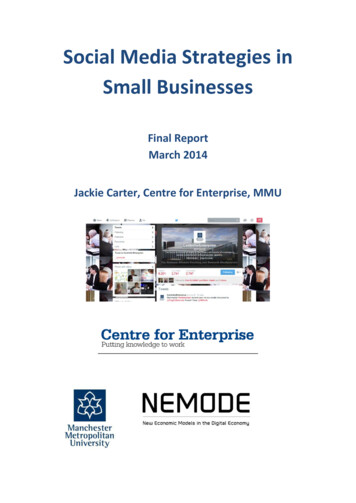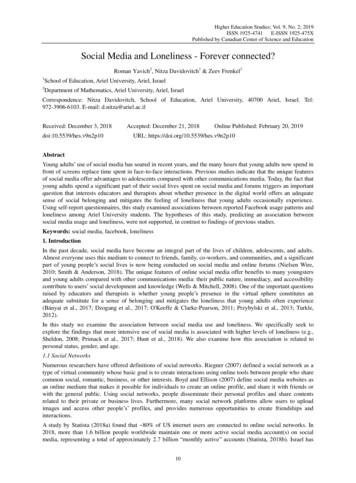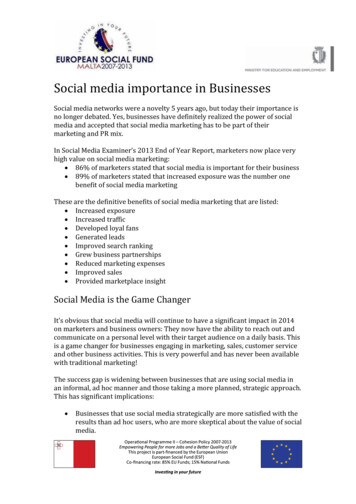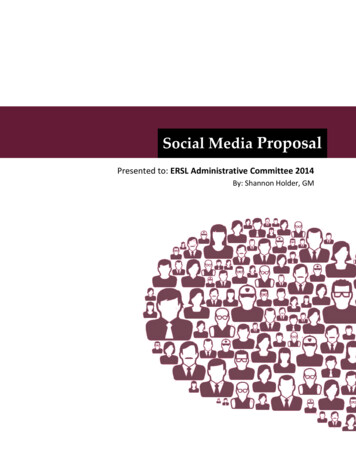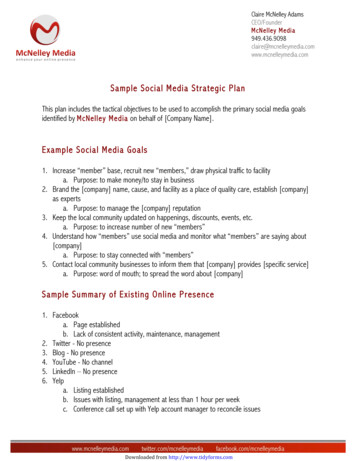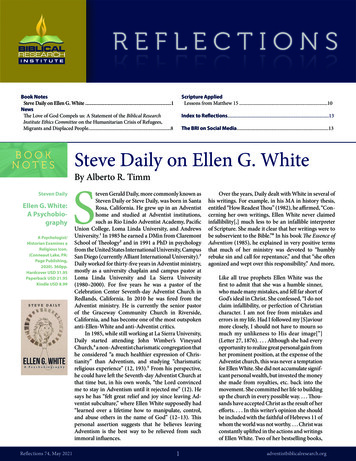
Transcription
Book NotesSteve Daily on Ellen G. White .1NewsThe Love of God Compels us: A Statement of the Biblical ResearchInstitute Ethics Committee on the Humanitarian Crisis of Refugees,Migrants and Displaced People.8Scripture AppliedLessons from Matthew 15 .10Index to Reflections.13The BRI on Social Media.13Steve Daily on Ellen G. WhiteBy Alberto R. TimmSteven DailyEllen G. White:A PsychobiographyA Psychologist/Historian Examines aReligious Icon.(Conneaut Lake, PA:Page Publishing,2020). 360pp.Hardcover USD 31.95Paperback USD 21.95Kindle USD 8.99Reflections 74, May 2021Steven Gerald Daily, more commonly known asSteven Daily or Steve Daily, was born in SantaRosa, California. He grew up in an Adventisthome and studied at Adventist institutions,such as Rio Lindo Adventist Academy, PacificUnion College, Loma Linda University, and AndrewsUniversity.1 In 1985 he earned a DMin from ClaremontSchool of Theology2 and in 1991 a PhD in psychologyfrom the United States International University, CampusSan Diego (currently Alliant International University).3Daily worked for thirty-five years in Adventist ministry,mostly as a university chaplain and campus pastor atLoma Linda University and La Sierra University(1980–2000). For five years he was a pastor of theCelebration Center Seventh-day Adventist Church inRedlands, California. In 2010 he was fired from theAdventist ministry. He is currently the senior pastorof the Graceway Community Church in Riverside,California, and has become one of the most outspokenanti-Ellen-White and anti-Adventist critics.In 1985, while still working at La Sierra University,Daily started attending John Wimber’s VineyardChurch,⁴ a non-Adventist charismatic congregation thathe considered “a much healthier expression of Christianity” than Adventism, and studying “charismaticreligious experience” (12, 193).⁵ From his perspective,he could have left the Seventh-day Adventist Church atthat time but, in his own words, “the Lord convincedme to stay in Adventism until it rejected me” (12). Hesays he has “felt great relief and joy since leaving Adventist subculture,” where Ellen White supposedly had“learned over a lifetime how to manipulate, control,and abuse others in the name of God” (12–13). Thispersonal assertion suggests that he believes leavingAdventism is the best way to be relieved from suchimmoral influences.1Over the years, Daily dealt with White in several ofhis writings. For example, in his MA in history thesis,entitled “How Readest Thou” (1982), he affirmed, “Concerning her own writings, Ellen White never claimedinfallibility[,] much less to be an infallible interpreterof Scripture. She made it clear that her writings were tobe subservient to the Bible.”⁶ In his book The Essence ofAdventism (1985), he explained in very positive termsthat much of her ministry was devoted to “humblyrebuke sin and call for repentance,” and that “she oftenagonized and wept over this responsibility.” And more,Like all true prophets Ellen White was thefirst to admit that she was a humble sinner,who made many mistakes, and fell far short ofGod’s ideal in Christ. She confessed, “I do notclaim infallibility, or perfection of Christiancharacter. I am not free from mistakes anderrors in my life. Had I followed my [S]aviourmore closely, I should not have to mourn somuch my unlikeness to His dear image[”](Letter 27, 1876). . . . Although she had everyopportunity to realize great personal gain fromher prominent position, at the expense of theAdventist church, this was never a temptationfor Ellen White. She did not accumulate significant personal wealth, but invested the moneyshe made from royalties, etc. back into themovement. She committed her life to buildingup the church in every possible way. . . . Thousands have accepted Christ as the result of herefforts. . . . In this writer’s opinion she shouldbe included with the faithful of Hebrews 11 ofwhom the world was not worthy. . . . Christ wasconstantly uplifted in the actions and writingsof Ellen White. Two of her bestselling books,adventistbiblicalresearch.org
Steps to Christ, and Desire of Ages, focus completely on Jesus. She proclaimed that Christwas the center of scripture, doctrine, faith,hope, goodness, the SDA message, and thebasis of all true religion. Those who wished touse her writings as an authori[ta]tive adjunctto the word of God in Christ were severelyrebuked by Ellen White in a speech she madeat the 1901 General Conference.⁷These appreciative statements appeared also inDaily’s more widely known book Adventism for a NewGeneration (1993).⁸Meanwhile, Daily began speaking more emphatically for social justice and sexual equality in regardto women’s ordination. In his DMin project “The Ironyof Adventism” (1985), he expressed his frustrationthat even after the 1848 Seneca Falls Convention onWomen’s Rights,⁹ Seventh-day Adventists continuedopposing those rights by “the ironic elevation ofa single woman [Ellen White], combined with asimultaneous subordination of women in general.”1⁰He believed thatPauline passages, which had traditionallybeen used to promote the subordination ofwives and other women, were generally eithersupported or left unchallenged in the writingsof Ellen White. Not only did she strongly subscribe to Paul’s declaration that the husbandwas head over the wife, but condemned anyaction on the part of women that detractedfrom the husbands “dignified position.”11Even so, Daily still recognized that White was“both a visionary and a recipient of the prophetic gift.”12Steve Daily’s critical stance towards White becamemore evident in his two-volume spiral-bound work TheProphetic Rift (2007 and 2009).13 Much in line withWayne A. Grudem,1⁴ Daily argued for “a huge difference” between the Old Testament prophets, whonegatively rebuked kings and high priests alike, and theNew Testament ones, who positively edified, exhorted,encouraged, and comforted God’s people. For him, “byconfusing these roles, Adventism imposed on EllenWhite an Old Testament role that was inappropriate forher and for the body as a whole, and she in turn imposedthis role on herself.”1⁵ Throughout these two volumes,Daily aligned himself with the major critics of Whitebut remained strangely silent about D. M. Canright.Daily declared of himself, “As one who has beenattacked by both the right and the left in Adventism, Iwant to make my case in favor of pluralism.”1⁶ But whatkind of “pluralism” was he actually arguing for? Hislater writings confirm that it was, among other things,a “pluralism” that implied the inclusion of the more“reliable” critics of White and the exclusion of her“biased” apologists.One would imagine that The Prophetic Rift wasalready the highpoint of Daily’s criticisms againstReflections 74, May 20212White. But in his book Ellen G. White: A Psychobiography, Daily leaves aside both the reliability of a historianand the ethical stand of a psychologist to become utterlyjudgmental of the already long-deceased White. Reading this book, the most natural assumption would bethat it was produced “out of spite or bitterness againstthe Adventist Church,” even though the author emphatically denies it (12). Yet, such a denial becomes doubtfulin light of the repeated and strong anti-Ellen-Whiteand anti-Adventism spirit that permeates the wholebook. It is noteworthy that the author even subtly triesto transfer to God his own responsibility for the publication of his book. He says, “I have prayed that if myown attempt at psychobiography provided in this bookwill do more harm than good, God will not allow itto be completed or published” (13). So, the reader isinduced to believe that, since God did not stop itspublication, He actually approved it.As a well-accepted pattern, reliable authors presentfirst the evidences for or against a given issue and thentheir conclusions based on those evidences. But Dailyreverses this pattern and already concludes in his introduction that “the matriarch of Adventism” was guiltyof “promoting a lie and a fraud” (10), that “her life contained patterns of premeditated fraud and deception,”as well as “patterns of narcissism and high-functioningsociopathy,” and that she “may have been one of themost successful con artists in history” (11).1⁷ These arenot mere hypotheses to be proven or assumptions tobe taken into consideration during the reading of thebook. They are indeed value judgments—colored withcountless labels and accusations—that set the tone forthe whole discussion that follows, in which the authortries to corroborate his well-defined and predetermined conclusions.The main content of the book is divided intofourteen chapters, each accusing White from variousperspectives. Due to the shortness of this review, onlya few of them will be mentioned. Chapter 1 claims, forinstance, that “prevarication” was the repeated pattern ofher life (23). In chapter 2, White’s twin sister Elizabethis referred to as a balanced person, while Ellen isportrayed as someone who would “even outdo thePharisees” in being blind to her own “ambition, control,dishonesty, and need for status, under the guise ofdoing God’s will” (33). Chapter 3 affirms that White“actually benefitted from the rock injury she experienced in her youth” to receive social and emotionalattention and sympathy (38–39) and that “many ofEllen’s visions, if not all, were conveniently invented”(40). In chapter 4, she is diagnosed as having sufferedfrom “cognitive dissonance and true-believer syndrome” (51), for “deliberately lying” or at least being“psychologically deluded” (57), and for being “theprimary source of pathology for the early SabbatarianAdventists” (60). In chapter 5, she is labeled as ahypocrite who coped with her own fears by building “afollowing of others who were controlled by fear”(74). In chapter 6, her entire life is regarded as “onehuge double bind” (84), always appeazing “to ‘visions’adventistbiblicalresearch.org
or divine guidance to put her detractors or enemies intheir place” (87). In chapter 7, she is described as havingshifted “from charismania to charisphobia” (91) andhaving “embraced the heresy of perfectionism andprojected its condemnations on to God” (99). In chapter8, she is diagnosed as having suffered from “grandiosedelusions” and having used “a false humility, designedto cover a lifetime pattern of dishonesty, fraud, Goddelusion and ‘holy’ plagiarism” (114–115). In chapter 9,she is qualified as a fraudulent person who developed“a premeditated plan that intentionally plots, deceives,manipulates, defrauds, and grossly misrepresents Godto others, in order to gain financial and political clout”(122) and as “one of the most successful con artists toever lead a movement” (135). Chapter 10 portrays heras an extremely jealous prophetic schizophrenic (141,145–146) whose “religious schizophrenia destroyedmany people over the years” (144). Chapter 11 speaksof her as “a religious bully, who would strike fear inthose who threatened her or question her, throughher prophetic trump card” (156–157), and of being “aseer into the personal lives and faults of others” (173).In chapter 12, she is qualified as “the most successfulplagiarist and con artist of all time” (188) and “apolitical wolf in sheep’s clothing” (215). Chapter 13portrays her as an arrogant person with a “matriarchalself ” who “went out of her way to try to present herself as the humble servant and instrument of God”(250–251). Finally, in chapter 14, she is labeled as “aglobe-trotter who not only traveled to Europe andAustralia, but also all over the United States” (282). Butthis is not all, for the author even claims that there are“fifty shades of pathology that are fascinating to explorein light of her creative malady” (46).From my reading of Daily’s book (and perhaps mymind is betraying me now), I recall having seen onlyone positive statement about White, where he deniesany suggestion from his part that the three cofoundersof Adventism (including Ellen) were “primarily greedyor self-seeking in their leadership” (82). But just threeparagraphs later, he accuses them of exercising a leadership that was of a “self-serving nature” (83). Whenyou start reading any of his many stories about her, youalready know the predictable outcome: she was alwayson the wrong side of the issues involved, and whenevershe was on the right side, it was only for political reasonsand financial advantages. Yet, when I read his versionof the story of Margaret W. Rowen, who claimed to bethe prophetic successor of White, I had no idea howhe would end it. But, in keeping with his negativepattern, he suggests White never named or supportedany successor because she “knew deep down that hergift was not a legitimate gift from God, as she claimed,”and because she wanted the enormous incomes fromher books to “continue to flow to her family” (278).Taking seriously Daily’s endless charges against White,one could imagine that she was perhaps the worst andmost hypocritical person who ever existed.But what led Daily to change his earlier positivestatements about White and write this psychobiographyReflections 74, May 20213of her that has become so ultra-critical and negative?Daily explains that back in 1984 he came across GeorgePickering’s book Creative Malady (1974)1⁸ and deeplyregretted that the author did not include a psychobiography of White (37–38). So, one could easily assumethat Daily is just doing now what Pickering could havedone then. However, in the introduction, Dailyexplains that this book is not just “a classic psychobiography” combining history and psychology.1⁹ In hisown words, “I have also sprinkled some theology andpersonal reflection throughout the book to make it myown unusual blend” (9–10). This “unusual blend” endsup being not an objective critical analysis of White, butrather a new way of vindicating the criticisms raisedagainst her while at the same time disregarding allresponses to those criticisms.Even so, the author disclaims any bitterness againstWhite. He says, “Again, it is not my purpose to try tolabel Ellen White with a postmortem diagnosis” (113),and “Here again, it is not my intention to diagnose theprophetess” (258). He even claims, “I do not seek to setmyself up as a judge over the prophetess” (297). Butone may wonder, why does he deny what he is doing soemphatically throughout his book? As incongruent asit may sound, he even concludes his whole expositionsaying, “As I bring this book to a close, it is my hopeand prayer that it has been interesting, informative,and helpful in terms of giving insights into how we canbetter treat each other as human beings” (301). Regardless of his good intentions, it is hard to see howlabeling, accusing, and being judgmental of others’motives (as he has done extensively) can help us to“better treat each other.”Yet how can we explain the contrast betweenDaily’s previous pro-Ellen-White position and hispresent anti-Ellen-White stand? Daily points to thepublication on the internet of “new material I havefound” “from suppressed areas of the [White Estate]vault (which I wasn’t even allowed to see as a historian)”(11). He even suggests, “The evidence used to supportthe validity of these criticisms was very convincingthen [when White was still alive], and is even moreoverwhelmingly today, given the new research that hascome to light” (247). But this question requires a moreconvincing answer than just the access to new historicalinformation (105, 294). White’s unpublished writingsto which he refers have been available for study byhistorians and researchers at E. G. White EstateResearch Centers (including the White Estate BranchOffice at Loma Linda University) long before theywere made available publicly on the internet. Further,the major criticisms against White—D. M. Canright(1889, 1919),2⁰ R. L. Numbers (1976, 1992),21 W. T. Rea(1982),22 and a few others—were already available whenDaily published his Adventism for a New Generation(1993), several of which he had cited in his MA thesis“How Readest Thou.” Could it be that what really happened was a radical change of his own perspective, inwhich all the critics of White became reliable sourcesof information (105) and all Adventist responses toadventistbiblicalresearch.org
those critics were discarded as unreliable excuses?The author claims to have used “325 references”throughout his book (301). Such a prolific number canbe a strength if the presuppositions are well in placeand the sources fairly reflect the available data; otherwise it becomes just another way of impressing thenot-so-well-informed reader. Unfortunately, Dailyis very selective in the use of sources, placing muchemphasis on those that confirm his views and simplyignoring those that disagree with him. For example,Francis D. Nichol’s classic Ellen G. White and Her Critics(1951)23 is referred to just once but as a “famous apologist work” with biased information (265, 357 [n. 295]).Several more recent books that respond to the verysame issues raised by Daily are not even criticallymentioned.2⁴ The insightful Ellen G. White IssuesSymposium series, published yearly since 2005 by theCenter for Adventist Research at Andrews University,is completely ignored.2⁵ More surprising is the fact thatthe outstanding Ellen G. White Encyclopedia (2013),2⁶considered “the most important reference work produced by the Seventh-day Adventist Church in a halfcentury,”2⁷ is mentioned just once among other sourcesin an endnote (340 [n. 39]). One would not expectDaily to quote all these sources or to necessarily agreewith their perspectives; but to simply ignore themthroughout the book suggests a bias, especially fromsomeone who considers himself a specialist in EllenWhite (172).Similar omissions with inaccuracies can be detectedin the way Steve Daily handles primary sources. Forexample, after suggesting that White fled to Australialargely because of her problems with plagiarism, hestates that “on March 20, 1889, the first public charge oraccusation of plagiarism against Ellen White to appearin the press was published in the Healdsburg Enterprise”and that it was a “five-page article” (186–187).2⁸ Dailyrefers to this as “the first public charge” without mentioning that it was D. M. Canright who was the mentorof all these charges, which he had already raised in hislectures in the Truitt’s Theater, Healdsburg, California(February 9–17, 1889) and which were already beingadvocated by him and the Pastors’ Union of Healdsburgin that newspaper.2⁹ The March 20 article was merelyanother short article signed by the “Pastors’ Union.”3⁰And more, how could that two-column article become a“five-page article” if the newspaper had only four pages?Nor should we overlook the fact that almost two yearsearlier, in 1887, Canright had already raised similarpublic accusations in the Michigan Christian Advocate.31This lack of historical precision and historical reliabilityclouds much of Daily’s research.Unfortunately, this historical inaccuracy is not anexception. Elsewhere, Daily affirms, “It is no wonderthat Adventists do not publish or reference Ellen’s willin their literature, for it is just another embarrassment”(285). This false statement is easily disclaimed by thefacts. The “Last Will and Testament of Mrs. Ellen G.White” was published entirely in F. D. Nichol’s Ellen G.White and Her Critics32 and H. E. Douglass’ MessengerReflections 74, May 20214of the Lord (1998),33 and partially in A. L. White’s EllenG. White (1982).3⁴ Daily cannot claim ignorance aboutthis matter, because he lists these three sources in thebibliography of his book (312, 316, 320). Furthermore,the complete will is available on the White Estate’swebsite as well as in the Adventist Digital Library.3⁵Similar carelessness is revealed when Daily misleadinglymakes Ellen White the author of a book edited byJames White and suggests that she borrowed (and even“attributed to God”) what James White simply reprinted from another properly identified author (94, 342 n.[62]).3⁶Surprising as it may sound, Daily has no difficultyin making Ellen White to advocate exactly what shewas condemning. In 1850 Joseph Bates published asixteen-page pamphlet entitled An Explanation of theTypical and Anti-Typical Sanctuary, by the Scriptures,suggesting that Christ would return “seven years” after1844—that is, in October 1851.3⁷ In November 1850,White warned, “The Lord showed me that time had notbeen a test since 1844, and that time will never again bea test.”3⁸ In July 1851, she stated in the same tone, “TheLord has shown me that the message of the third angelmust go, . . . and that it should not be hung on time; fortime will never be a test again. . . . I saw that some weremaking everything bend to the time of this next fall—that is, making their calculations in reference to thattime.”3⁹ Nonetheless, Daily repeatedly speaks of Whiteas the great promoter of this theory and even as havingbeen shamefully disappointment by it (51–53, 58, 64,66, 69, 80, 82, 85, 86, 91, 101, 105, 119, 128–129, 142).One of the most recurrent themes of the book isWhite as a plagiarist. After qualifying her as “the mostsuccessful plagiarist and con artist of all time” (188), heasserts, “The reality was that if proper attribution hadoccurred, there would have been nothing significantcontributed by the author. Ellen was taking virtuallyall of her history, theology, thoughts, and other contentfrom other authors without attribution” (189). For thesake of record, in 1986 the Ellen G. White Estate produced an important document entitled, “Ellen White’sLiterary Sources: How Much Borrowing Is There?” Thisdocument has been updated over the years to reflectknown literary borrowings by White identified byboth her supporters and her critics.⁴⁰ This documentdemonstrates a much lower percentages of borrowingthan Steve Daily claims. His conclusions do not reflectthe latest available research on this question.Steve Daily not only labels White and her husbandbut also those who do not see things from his perspective and who disagree with his conclusions. He states inunambiguous terms, “Any fair-minded person who isexposed to the evidence is forced to conclude that Ellenwas guilty of illegal acts, immoral acts, lying, deception,and fraud, along with some serious psychologicalpathology” (112). In other words, if you do notagree with this assessment, you are most likely not a“fair-minded person.” Those who accept her propheticgift are labeled as “disciples blindly following” her (113),and those who try to justify her statements are regardedadventistbiblicalresearch.org
as trying “to put blinders on where their religious icon isconcerned” (125). For him, it seems not to be an ethicalproblem to insinuate that people who accept White’sprophetic gift are lower-class con artists following “themost successful con artist in history” (261). Those whotry to defend White from his criticisms are alreadylabeled as “hard-core apologists (contortionists)” (262).If Daily’s arguments are as convincing and conclusive as he proposes they are, they should fairly reflectthe available evidence. But as has been shown, thisunfortunately is not always the case. Is that the reasonwhy he needs to use so much labeling in his arguments?Why does he not simply present his case and then allowthe readers to evaluate its validity? His rhetorical techniques seem manipulative and unfair. This same stylewas not used (at least to this extent) in his previousbooks. Others may even wonder if this is the typicallanguage of psychobiography. Not necessarily. WilliamStrunk Jr. and E. B. White point out, “When youoverstate, readers will be instantly on guard, and everything that has preceded your overstatement as well aseverything that follows it will be suspect in their mindsbecause they have lost confidence in your judgment oryour poise.”⁴1Daily wants “the reader [to] draw his or her ownconclusions” (258), and even adds, “I strongly encouragethe reader to carefully evaluate this material and makeyour own judgment. . . . My prayer is that you will weighthe evidence for yourselves, and draw your own conclusions” (301). But these final concessions are precededby continuous attempts to persuade the readers tosee things from his perspective. This is evident in thelittle quizzes (questions) at the end of each chapter,in which the answer is already suggested based on hisown conclusions. For example, at the end of the introduction he asks, “After reading this book, where wouldyou put Ellen White on a scale from 1 to 10, with 10 beinghealthy religion?” (14). At the end of chapter 14, he asks,“What is more disturbing, the fraud and plagiarism ofEllen White, or the continuing cover-up of this fraudand plagiarism by SDA leaders who orchestrated thedeath of prophecy?” (296).Daily’s book is not just a mere attempt to discreditthe character and prophetic ministry of White. It isindeed an appeal for Adventists to reject all their “cultic”doctrines (including the sanctuary, the investigativejudgment, the law and the Sabbath, the dead sleep,etc.) and to experience the “relief and joy” felt by Dailyafter “leaving Adventist subculture” (12, 193) and byHerbert Armstrong’s Worldwide Church of God afterdeciding in 1997 “to shed its Old Covenant and culticteachings and embrace mainline orthodox Christianity” (294–295).⁴2By continually overstating and twisting the historical facts, one wonders if the book perhaps reveals moreabout Daily than about White. Too often “our philosophybecomes the history of our own heart and life; and according to what we ourselves are, do we conceive of manand his vocation.”⁴3 After reading this book, one endsup with the unavoidable question: to what extent hasReflections 74, May 20215Daily’s psychobiography been conditioned by his ownpersonal frustrations with White and the Seventh-dayAdventist Church? Such a negative portrayal of Whiteas he provides is disclaimed by the results of Roger L.Dudley and Des Cummings Jr., with more than 8,200Seventh-day Adventists.⁴⁴ This empirical study revealedthat those who read White have a much strongerrelationship with Jesus, assurance of salvation, personalBible study, family worship, etc. Thus, as well expressedin Francis D. Nichol’s ironic words,if such mental illness as Mrs. White is supposed to have suffered from will produce a lifeof sacrificial service and ardor, of far missionplanning, of counsel to holy living and highstandards, of selfless love for the needy, and allthe other Christian graces that radiated fromher life, then we would say solemnly, God giveus more mentally maladjusted people.⁴⁵The issues raised by Daily in his book are not newand have been addressed in previous publications.⁴⁶Even so, it might be interesting to more closely comparethe out-of-Adventism spiritual journeys of both Canright and Daily, paralleling Canright’s The Life of EllenG. White (1919) and Daily’s Ellen White: A Psychobiography, and exploring their levels of historical reliability⁴⁷and rhetorical techniques.⁴⁸ But such assessmentsshould always be ethically and legally responsible,⁴⁹taking into consideration Christ’s warning againstjudging the inner motives of others (Matt 7:1).One should read and apply the writings of Whitefirst himself or herself before applying them to others.She declares,Do not set yourself up as a standard. Donot make your opinions, your views of duty,your interpretations of Scripture, a criterion forothers and in your heart condemn them if theydo not come up to your ideal. Do not criticizeothers, conjecturing as to their motives andpassing judgment upon them. . . . We cannotread the heart. Ourselves faulty, we are notqualified to sit in judgment upon others. Finitemen can judge only from outward appearance.To Him alone who knows the secret springs ofaction, and who deals tenderly and compassionately, is it given to decide the case ofevery soul.⁵⁰You may be true to principle, you maybe just, honest, and religious; but with it allyou must cultivate true tenderness of heart,kindness, and courtesy. If a person is in error,be the more kind to him; if you are notcourteous, you may drive him away fromChrist. Let every word you speak, even thetones of your voice, express your interest in,and sympathy for, the souls that are in peril. Ifyou are harsh, denunciatory, and impatient withthem, you are doing the work of the enemy.⁵1adventistbiblicalresearch.org
Since we cannot read the heart of another,let us beware of ascribing wrong motives toany man, lest we find ourselves involved inguilt similar to that of Miriam—condemningthose whom the Lord is teaching and guiding—and thus bring upon ourselves the rebukeof God.⁵2Throughout the book there is a pervasive negativeand even destructive spirit toward White that is voicedin a rather tendentious and biased manner. Even conflicting ideas and concepts should be discussed withoutbecoming so judgmental. Unfortunately, this is not thecase in this book. Furthermore, there is a repeated patterndiscernable where historical evidence is not accurately1 See “Steve Daily,” Facebook, https://www.facebook.com/stevengdailyphd (accessed April 25, 2021).2 Steven Daily, “The Irony of Adventism: The Role of Ellen White andOther Adventist Women in Nineteenth Century America” (DMinproject, Claremont School of Theology, 1985).3 Steven Gerald Daily, “Adventist Adolescents and Addiction: SubstanceUse/Abuse in an Adventist Population and Its Relationship toReligion, Family, Self-Perception, and Deviant Behavior” (PhD diss.,United States International University, Campus San Diego, 1991).⁴ On John Wimber and the Vineyard Church, see “John Wimber,”Vineyard USA, http
Even so, Daily still recognized that White was “both a visionary and a recipient of the prophetic gift.” 12 Steve Daily’s critical stance towards White became more evident in his two-volume spiral-bound work . The Prophetic Rift (2007 and 2009).13 Much in line with Wayne A.



